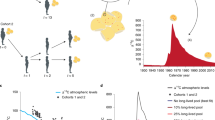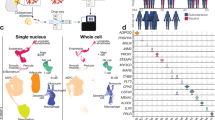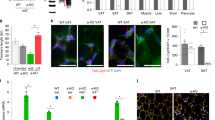Abstract
Obesity is increasing in an epidemic manner in most countries and constitutes a public health problem by enhancing the risk for cardiovascular disease and metabolic disorders such as type 2 diabetes1,2. Owing to the increase in obesity, life expectancy may start to decrease in developed countries for the first time in recent history3. The factors determining fat mass in adult humans are not fully understood, but increased lipid storage in already developed fat cells (adipocytes) is thought to be most important4,5. Here we show that adipocyte number is a major determinant for the fat mass in adults. However, the number of fat cells stays constant in adulthood in lean and obese individuals, even after marked weight loss, indicating that the number of adipocytes is set during childhood and adolescence. To establish the dynamics within the stable population of adipocytes in adults, we have measured adipocyte turnover by analysing the integration of 14C derived from nuclear bomb tests in genomic DNA6. Approximately 10% of fat cells are renewed annually at all adult ages and levels of body mass index. Neither adipocyte death nor generation rate is altered in early onset obesity, suggesting a tight regulation of fat cell number in this condition during adulthood. The high turnover of adipocytes establishes a new therapeutic target for pharmacological intervention in obesity.
This is a preview of subscription content, access via your institution
Access options
Subscribe to this journal
Receive 51 print issues and online access
$199.00 per year
only $3.90 per issue
Buy this article
- Purchase on Springer Link
- Instant access to full article PDF
Prices may be subject to local taxes which are calculated during checkout




Similar content being viewed by others
References
Van Gaal, L. F., Mertens, I. L. & De Block, C. E. Mechanisms linking obesity with cardiovascular disease. Nature 444, 875–880 (2006)
Kahn, S. E., Hull, R. L. & Utzschneider, K. M. Mechanisms linking obesity to insulin resistance and type 2 diabetes. Nature 444, 840–846 (2006)
Olshansky, S. J. et al. A potential decline in life expectancy in the United States in the 21st century. N. Engl. J. Med. 352, 1138–1145 (2005)
Bjorntorp, P. Effects of age, sex, and clinical conditions on adipose tissue cellularity in man. Metabolism 23, 1091–1102 (1974)
Hirsch, J. & Batchelor, B. Adipose tissue cellularity in human obesity. Clin. Endocrinol. Metab. 5, 299–311 (1976)
Spalding, K. L., Bhardwaj, R. D., Buchholz, B. A., Druid, H. & Frisen, J. Retrospective birth dating of cells in humans. Cell 122, 133–143 (2005)
Prins, J. B. & O’Rahilly, S. Regulation of adipose cell number in man. Clin. Sci. (Lond.) 92, 3–11 (1997)
Knittle, J. L., Timmers, K., Ginsberg-Fellner, F., Brown, R. E. & Katz, D. P. The growth of adipose tissue in children and adolescents. Cross-sectional and longitudinal studies of adipose cell number and size. J. Clin. Invest. 63, 239–246 (1979)
Miller, M. et al. Demonstration of de novo production of adipocytes in adult rats by biochemical and radioautographic techniques. J. Lipid Res. 25, 336–347 (1984)
Kral, J. et al. Body composition and adipose tissue cellularity before and after jejuno-ileostomy in severely obese subjects. Eur. J. Clin. Inv. 7, 413–419 (1977)
Björntorp, P. et al. Effect of an energy reduced dietry regimen in relation to adipose tissue cellularity in obese women. Am. J. Clin. Nut. 28, 445–452 (1975)
Häger, A. et al. Adipose tissue cellularity in obese school girls before and after dietary intervention. Am. J. Clin. Nut. 31, 68–75 (1978)
Sims, E. A. et al. Experimental obesity in man. Trans. Assoc. Am. Physicians 81, 153–170 (1968)
Rodriguez, A. M., Elabd, C., Amri, E. Z., Ailhaud, G. & Dani, C. The human adipose tissue is a source of multipotent stem cells. Biochimie 87, 125–128 (2005)
Petruschke, T. & Hauner, H. Tumor necrosis factor-α prevents the differentiation of human adipocyte precursor cells and causes delipidation of newly developed fat cells. J. Clin. Endocrinol. Metab. 76, 742–747 (1993)
Prins, J. B., Walker, N. I., Winterford, C. M. & Cameron, D. P. Apoptosis of human adipocytes in vitro . Biochem. Biophys. Res. Commun. 201, 500–507 (1994)
Cinti, S. et al. Adipocyte death defines macrophage localization and function in adipose tissue of obese mice and humans. J. Lipid Res. 46, 2347–2355 (2005)
Bhardwaj, R. D. et al. Neocortical neurogenesis in humans is restricted to development. Proc. Natl Acad. Sci. USA 103, 12564–12568 (2006)
De Vries, H. Atomic bomb effect: variation of radiocarbon in plants, shells, and snails in the past 4 years. Science 128, 250–251 (1958)
Nydal, R. & Lovseth, K. Distribution of radiocarbon from nuclear tests. Nature 206, 1029–1031 (1965)
Levin, I. & Kromer, B. The tropospheric 14CO2 level in mid latitudes of the northern hemisphere (1959–2003). Radiocarbon 46, 1261–1272 (2004)
Spalding, K. L., Buchholz, B. A., Bergman, L. E., Druid, H. & Frisen, J. Forensics: age written in teeth by nuclear tests. Nature 437, 333–334 (2005)
Libby, W. F., Berger, R., Mead, J. F., Alexander, G. V. & Ross, J. F. Replacement rates for human tissue from atmospheric radiocarbon. Science 146, 1170–1172 (1964)
Harkness, D. D. Further investigations of the transfer of bomb 14C to man. Nature 240, 302–303 (1972)
Altman, D. G. Practical Statistics for Medical Research pp 164 (Chapman & Hall, CRC, London, 1991)
Löfgren, P. et al. Long-term prospective and controlled studies demonstrate adipose tissue hypercellularity and relative leptin deficiency in the post-obese state. J. Clin. Endocrinol. Metab. 90, 6207–6213 (2005)
Freedman D. S. et al. Relationship of childhood overweight to coronary heart disease. Risk factors in adulthood: The Bogalusa Heart Study. Pediatrics 108, 712–718 (2001)
Raff, M. C. Size control: the regulation of cell numbers in animal development. Cell 26, 173–175 (1996)
Joulia-Ekaza, D. & Cabello, G. Myostatin regulation of muscle development: molecular basis, natural mutations, physiopathological aspects. Exp. Cell Res. 312, 2401–2414 (2006)
Stuiver, M. & Polach, H. A. Reporting on 14C data. Radiocarbon 19, 355–363 (1977)
Acknowledgements
We thank M. Stahlberg and T. Bergman for help with high-performance liquid chromatography (HPLC), D. Kurdyla, P. Zermeno and A. Williams for producing graphite, and S. Zdunek for comments on the statistics and modelling. This study was supported by grants from Knut och Alice Wallenbergs Stiftelse, the Human Frontiers Science Program, the Swedish Research Council, the Swedish Cancer Society, the Swedish Heart and Lung foundation, the Novo Nordic Foundation, the Swedish Diabetes Foundation, the Foundation for Strategic Research, the Karolinska Institute, the Tobias Foundation, AFA Life Insurance Health Foundation and NIH/NCRR (RR13461). This work was performed in part under the auspices of the US Department of Energy by University of California, Lawrence Livermore National Laboratory under contract W-7405-Eng-48.
Author Contributions K.L.S., P.A. and J.F. designed the study and wrote the manuscript. E.A., P.O.W., S.B., O.B. and T.B. were responsible for the modelling and statistics. K.L.S. and B.A.B. performed sample preparation and 14C accelerator mass spectrometry measurements. L.B., J.H. and E.N. collected clinical material. H.C., M.H. and M.R. performed studies on fat cell purity.
Author information
Authors and Affiliations
Corresponding authors
Supplementary information
Supplementary information
The file contains Supplementary Notes including model and curve fit for fat cell data measuring average fat cell volume against body fat mass; Supplementary Table showing all data from the thirty-five people whose adipose DNA was carbon dated; modelling of 14C data; methodologies and additional references. (PDF 1007 kb)
Rights and permissions
About this article
Cite this article
Spalding, K., Arner, E., Westermark, P. et al. Dynamics of fat cell turnover in humans. Nature 453, 783–787 (2008). https://doi.org/10.1038/nature06902
Received:
Accepted:
Published:
Issue Date:
DOI: https://doi.org/10.1038/nature06902
This article is cited by
-
White adipocyte dysfunction and obesity-associated pathologies in humans
Nature Reviews Molecular Cell Biology (2024)
-
A spatiotemporal proteomic map of human adipogenesis
Nature Metabolism (2024)
-
In Vitro Screening and Lipid-Lowering Effect of Prickly Pear (Opuntia Ficus-Indica L. Mill.) Fruit Extracts in 3T3-L1 Pre-Adipocytes and Mature Adipocytes
Plant Foods for Human Nutrition (2024)
-
Adipose Tissue Plasticity and Insulin Signaling in the Pathogenesis of Type 2 Diabetes
Diabetology International (2024)
-
The association of gestational age and birthweight with blood pressure, cardiac structure, and function in 4 years old: a prospective birth cohort study
BMC Medicine (2023)
Comments
By submitting a comment you agree to abide by our Terms and Community Guidelines. If you find something abusive or that does not comply with our terms or guidelines please flag it as inappropriate.



